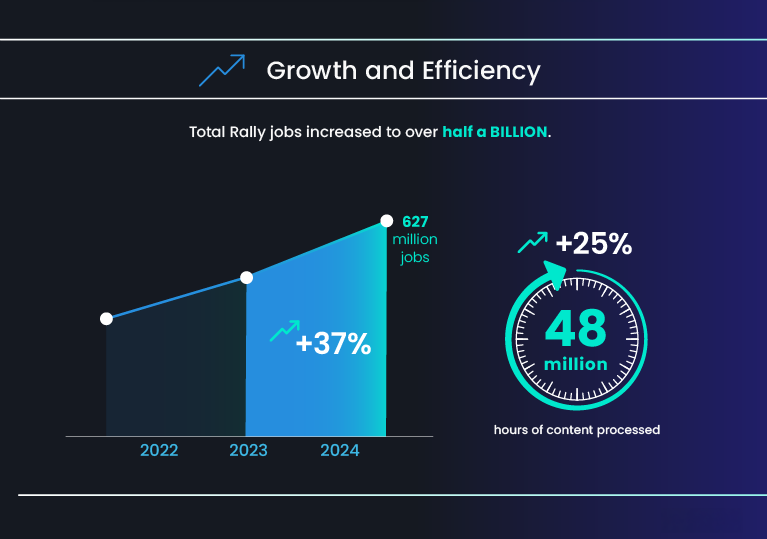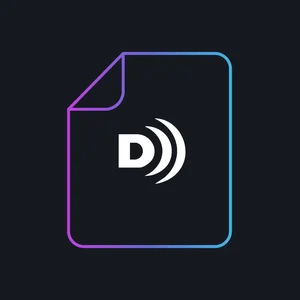sdvi update
A Look Back at 2024… By The Numbers
Every January, we examine a year’s worth of data from the Rally platform to find out what it can tell us about the big trends or important changes our customers are experiencing. We bundle those data points and insights into our By The Numbers infographic.
What did we learn about 2024?
It was a record year for cloud-based media operations, highlighted by tremendous growth in usage of the Rally platform: over half a billion jobs performed!
Much of this growth was driven by media companies preparing content for international distribution and to support new licensing deals with global D2C services.
Check out the complete data in our blog.
Supply Chain Thinking
Better Together: The Power of Partnerships

Geoff Stedman, Chief Marketing Officer
Each year, we put together our By The Numbers infographic capturing the scale of work moving through the SDVI Rally platform. And every year, the numbers are impressive. But this time, we hit a head-turning milestone: 627 million jobs processed in a single year. We’ve blown by the half-billion mark, and we got there faster than any of us imagined.
That 627 million number got me thinking about how, though we’ve addressed scalability in many ways, we’ve never really stepped back to explore what scale means in a media supply chain. Earlier blog posts (including this blog series) examine ways that cloud-native infrastructure brings flexibility and efficiency to media workflows, but what about the impact of scaling media supply chains?
We’re seeing that true scalability really is about more than size, or expanding your capacity. It’s about being ready for anything, whether that means handling more work than ever before or dialing resources down to match shifting demand. It’s about being able to say “yes” when opportunity comes knocking and keeping resources aligned with demand when you finish the job.
In the blog, we reflect on what scalability means for media companies, and how true scalability matches resources to work at the most precise level.
From Our Technical Solutions Team: Using Rally Decision Engine to Streamline Media Accessibility


Julien Gosnet, Solution Architect & Paul Ledgard, Technical Account Manager
Editor’s note: “What was your favorite problem you helped solve in the past year?” This is the question we posed to our Technical Solutions team at the start of the year. Their answers reveal some of the best problem-solving taking place on Rally media supply chains today. This is the second in their series of answers.
The Problem
In Canada, larger television broadcasters must provide described video for all English- and French-language programming that is broadcast during prime time. Described video (or DV) is an accessibility feature that helps people who are blind or visually impaired understand what’s happening on-screen.
One of our new customers ingests a high volume of content from a large media distributor, however, the described video is not always provided. As a result, this customer was scheduling content for prime time and ordering the associated described video from an external service provider, 3Play Media, in parallel.
The customer’s operations team would have to manually pick the proxy, upload it, then come back later and place it’s DV order within 3Play. Once ready, the team would go through a series of cumbersome manual steps to pull in the DV, reassociate it with the asset, reprocess, and schedule for linear.
This whole process created unnecessary disruption in the automated media supply chain.
How did you approach the modernization of this DV workflow?
To create a more streamlined, automated process for this customer, we designed a solution leveraging APIs and SDVI Rally Decision Engine. In the blog, we share more detail about the customer’s new streamlined and automated supply chain, which allows the customer to complete the DV workflow in just two clicks.
New in Rally
Multiregion Redundancy Enhancements
Rally users now can run anonymous supply chains on remote assets. These supply chains get started with the Remote Asset ID available in the context data, allowing supply chain engineers to access any needed information — such as metadata and status markers — stored about the remote asset.
This information can be used to start appropriate local supply chains automatically to create a local asset and, in the event of regional outages, continue any necessary steps to finish work on the asset. The remote asset search and remote asset information are also available via the Rally API, enabling users in multiregion deployments to integrate this functionality into other operational systems.
These is just one of the recent updates made to the Rally platform. Read more in our latest Rally Updates blog.

Partner Spotlight
Bitmovin Encoding Templates
Encoding Templates give you all the powerful features you love for VOD Encoding with just one endpoint. Encoding Templates are written in YAML, as there is less visual clutter in comparison to JSON, and YAML is a superset of JSON. Additionally, you can enrich your Encoding Template with comments to explain configuration decisions.
The new template service follows the same hierarchy as the SDK, so it is easier to construct new Encoding Templates from scratch and understand where to place the objects in the YAML. Bitmovin also offers a JSON schema to validate your Encoding Template YAML files.
Learn more about the full spectrum of best-in-class tools in the Rally Application Services Market.






